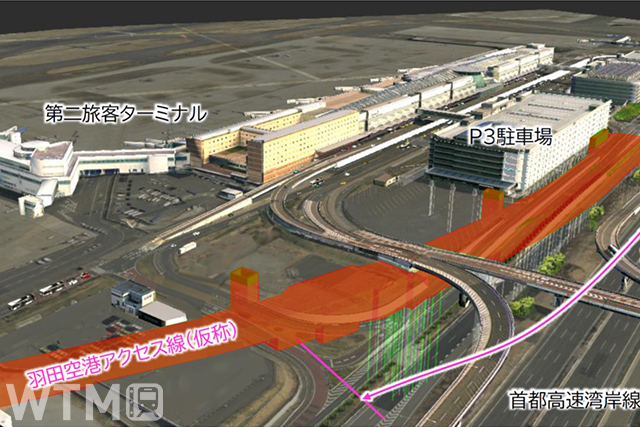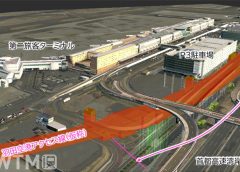As part of the “Haneda Airport Access Line (tentative name)” plan, which will enable access to Haneda Airport from various directions without having to change trains, JR East will begin construction of the “East Yamaote Route” and the “Access New Line” connecting directly toward Tokyo Station.

Direct access to Haneda Airport in 18 minutes
The overall plan is to construct the “Access New Line” from Haneda Airport, and run through existing JR lines for Shinjuku and Ikebukuro / for Utsunomiya, Takasaki and Joban / for Chiba. In April 2016, the government’s transport policy council reported that it was positioned as a “railway network project that contributes to strengthening international competitiveness,” and JR East is preparing for commercialization.
Of the planned routes, a groundbreaking ceremony will be held in June 2023 for the East Yamanote Route, which will connect to the Tokaido Line near Tamachi Station and lead directly to Tokyo Station, as well as the Access New Line. The construction work will be started with the aim of opening until March 2032.
If you use the train from Tokyo Station to Haneda Airport, it currently takes about 30 minutes, but after opening, it will be much faster, about 18 minutes, and you will not need to change trains. In addition, direct access to the Utsunomiya, Takasaki and Joban Lines via the Ueno-Tokyo Line will improve airport access from a wide area (See the chart below for detail such as the overview of plans for Haneda Airport Access Line, the construction section map of East Yamate Route).
![[Chart] The overview of plans for Haneda Airport Access Line, the construction section map of East Yamate Route](https://en.wtmnews.net/wp-content/uploads/sites/3/2023/05/b7c589b48376f461e6108c72f316b3fe.png)
Combination of former freight line and new tunnel
Of the sections under construction this time, the section from the Tokaido Line connection to the Tokyo Freight Terminal is called the “East Yamanote Route,” and the Ministry of Land, Infrastructure, Transport and Tourism (MLIT) approved changes to railway facilities on January 31, 2023 (Tue). The “Oshio Line”, a freight line that has been suspended since 1998, will be used effectively, and existing facilities such as bridges and viaducts will be renovated and improved for passengerization.
Side tracks of the Yamanote Line on the Tokyo side of Tamachi Station will be removed, and the Yamanote Line outer track, Keihin-Tohoku Line southbound, and Tokaido Line inbound track will be relocated in sequence. As a result, new space will be secured between the tracks of both directions of the Tokaido Line, and the connection line of the Tokaido Line and the Oshio Line will be laid in the tunnel to be constructed here.
In addition, within the Tokyo Freight Terminal, approximately 23,000 square meters of land owned by JR East will be used to develop the vehicle storage lines and maintenance base lines necessary for operating the Haneda Airport Access Line.
The section from the freight terminal to the Haneda Airport New Station (tentative) is the “Access New Line” section for which MLIT has issued construction approval on March 24, 2023 (Fri). As an extension of the Oshio Line, a new double-track shield tunnel with a length of about 4.2 km will be constructed that will pass under public facilities, roads and canals at a maximum depth of about 50 m.
Haneda Airport New Station will be a shallow underground station on the first basement floor, built under the airport premises road between Terminals 1 and 2. The island platform serving two tracks has a maximum width of about 12m and a length of about 310m. You can move from the platform to Terminal 2 with no difference in elevation.
On the other hand, since Terminal 1 is located across the Metropolitan Expressway and national highway, it is relatively far away, and it is necessary to access via existing underground passages.
Haneda Airport’s importance as a metropolitan airport is increasing with the expansion of inbound demand, and strengthening rail access is positioned as an initiative that will lead to the enhancement of airport functions. The infrastructure for stations and tunnels on the airport island is part of the airport development project, and the Japanese government will take the lead in constructing shield tunnels and cut-and-cover tunnels.


 [Japan] Tokyo Skytree Observatory Advance Ticket | Enjoy the captivating panoramic view of the Tokyo skyline (Ad by KKday)
[Japan] Tokyo Skytree Observatory Advance Ticket | Enjoy the captivating panoramic view of the Tokyo skyline (Ad by KKday) [Japan] Tokyo Subway 24/48/72-hr Ticket | Enjoy one of the most affordable ways to travel around the Tokyo metropolitan area (Ad by KKday)
[Japan] Tokyo Subway 24/48/72-hr Ticket | Enjoy one of the most affordable ways to travel around the Tokyo metropolitan area (Ad by KKday)



